Neisseria meningitidis - Eurosurveillance
Neisseria meningitidis - Eurosurveillance
Neisseria meningitidis - Eurosurveillance
Create successful ePaper yourself
Turn your PDF publications into a flip-book with our unique Google optimized e-Paper software.
the variants for which this is the case for cannot be<br />
known without exhaustive, or at least extensive, sampling<br />
over time.<br />
The MLST approach catalogues this extreme diversity,<br />
which is seen in many microbial populations and<br />
which remains only partially explored, by the maintenance<br />
of curated libraries of allele sequences for each<br />
MLST locus. Each unique sequence (allele) is assigned<br />
a unique arbitrary number, effectively compressing<br />
400–600 bp of information into a single integer.<br />
Further organisation and compression of genetic variation<br />
is attained by combining the data from all MLST<br />
loci into allelic profiles or sequence types (STs), which<br />
are also assigned arbitrary numeric designations, each<br />
of which defines a unique string of several thousand<br />
nucleotides [12]. This approach has proved to be both<br />
efficient and effective: as of November 2012, there<br />
were 9,927 STs in the <strong>Neisseria</strong> MLST database, for<br />
example, each precisely characterising a particular<br />
seven-locus <strong>Neisseria</strong> genotype. Similar levels of diversity<br />
have been observed in other bacteria hosted at<br />
PubMLST and on other MLST repositories [14]. The fact<br />
that nearly 10,000 distinct variants of only 3,284 bp of<br />
coding sequence under stabilising selection are known<br />
to exist in one human-associated bacterium with a<br />
genome of about 2.2 Mbp indicates the scale of the<br />
cataloguing problem facing us in the era of genomic<br />
microbiology.<br />
Nevertheless, there are instances when even the very<br />
high levels of diversity routinely seen in MLST datasets<br />
do not provide sufficient information for clinical<br />
decision-making. This is because even populations of<br />
Figure 1<br />
Schematic of one of the <strong>Neisseria</strong> <strong>meningitidis</strong> MLST loci (abcZ ) showing the number and positions of known polymorphic<br />
sites within the gene fragment (unmodified PubMLST.org screenshot)<br />
MLST: multilocus sequence typing.<br />
Source: PubMLST <strong>Neisseria</strong> website [13].<br />
30 www.eurosurveillance.org
















